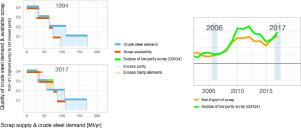Resources, Conservation and Recycling ( IF 13.2 ) Pub Date : 2021-06-05 , DOI: 10.1016/j.resconrec.2021.105692 Sabine Dworak , Johann Fellner

|
A detailed understanding of scrap generation and utilization is needed to target increased material efficiencies and circular economy in the steel industry. In the present paper, the generation and composition of steel scrap (production & forming scrap, fabrication scrap and post-consumer scrap and their composition) in the former territory of the EU-28 have been assessed from 1946 to 2017 by means of Material Flow Analysis. The results reveal that the steel scrap composition in the EU-28 has changed significantly since 1946. Until 1980 scrap generation was dominated by new scrap (mostly production & forming scrap). Today, most of the overall steel scrap is post-consumer scrap. Most of the new scrap consists of fabrication scrap. Taking the presence and tolerance levels of major tramp elements in steel (Cu, Sn, Cr, Ni and Mo) into consideration, a material pinch analysis reveals a surplus of steel scrap with higher levels of tramp elements since the 1990ies. This scrap could only be utilized in the European steel industry by dilution with primary iron sources. At present, this surplus scrap seems to be largely exported as its quantity corresponds well to the net-exports of steel scrap from the EU-28. Transplanting the observed trends of steel scrap generation to emerging economies implies a significant increase in fabrication and post-consumer scrap in these countries in the near future. However, the utilization of scrap at higher rates, particularly post-consumer scrap, will challenge the local steel industry as tramp elements significantly increase along the production, use and end-of-life chain.
中文翻译:

自 1946 年以来欧盟 28 国的废钢产生——来源和组成
需要详细了解废料的产生和利用,以提高钢铁行业的材料效率和循环经济。在本文中,欧盟 28 国前领土废钢(生产和成型废料、制造废料和消费后废料及其组成)的产生和成分已通过材料流评估了 1946 年至 2017 年分析。结果表明,欧盟 28 国的废钢成分自 1946 年以来发生了显着变化。直到 1980 年,废钢的产生主要是新废钢(主要是生产和成型废钢)。今天,大部分废钢是消费后废钢。大多数新废料包括制造废料。考虑钢中主要杂质元素(Cu、Sn、Cr、镍和钼),材料夹点分析显示,自 1990 年代以来,废钢过剩且杂质元素含量较高。这种废料只能通过用初级铁源稀释后用于欧洲钢铁工业。目前,这种过剩的废钢似乎主要出口,因为其数量与欧盟 28 国废钢的净出口相当。将观察到的废钢产生趋势移植到新兴经济体意味着在不久的将来这些国家的制造和消费后废钢将显着增加。然而,废钢(尤其是消费后废钢)的高利用率将对当地钢铁行业构成挑战,因为生产、使用和报废链中的杂质元素显着增加。材料夹点分析显示,自 1990 年代以来,废钢过剩且杂质元素含量较高。这种废料只能通过用初级铁源稀释后用于欧洲钢铁工业。目前,这种过剩的废钢似乎主要出口,因为其数量与欧盟 28 国废钢的净出口相当。将观察到的废钢产生趋势移植到新兴经济体意味着在不久的将来这些国家的制造和消费后废钢将显着增加。然而,废钢(尤其是消费后废钢)的高利用率将对当地钢铁行业构成挑战,因为生产、使用和报废链中的杂质元素显着增加。材料夹点分析显示,自 1990 年代以来,废钢过剩且杂质元素含量较高。这种废料只能通过用初级铁源稀释后用于欧洲钢铁工业。目前,这种过剩的废钢似乎主要出口,因为其数量与欧盟 28 国废钢的净出口相当。将观察到的废钢产生趋势移植到新兴经济体意味着在不久的将来这些国家的制造和消费后废钢将显着增加。然而,废钢(尤其是消费后废钢)的高利用率将对当地钢铁行业构成挑战,因为生产、使用和报废链中的杂质元素显着增加。这种废料只能通过用初级铁源稀释后用于欧洲钢铁工业。目前,这种过剩的废钢似乎主要出口,因为其数量与欧盟 28 国废钢的净出口相当。将观察到的废钢产生趋势移植到新兴经济体意味着在不久的将来这些国家的制造和消费后废钢将显着增加。然而,废钢(尤其是消费后废钢)的高利用率将对当地钢铁行业构成挑战,因为生产、使用和报废链中的杂质元素显着增加。这种废料只能通过用初级铁源稀释后用于欧洲钢铁工业。目前,这种过剩的废钢似乎主要出口,因为其数量与欧盟 28 国废钢的净出口相当。将观察到的废钢产生趋势移植到新兴经济体意味着在不久的将来这些国家的制造和消费后废钢将显着增加。然而,废钢(尤其是消费后废钢)的高利用率将对当地钢铁行业构成挑战,因为生产、使用和报废链中的杂质元素显着增加。这种过剩的废钢似乎主要出口,因为其数量与欧盟 28 国废钢的净出口相当。将观察到的废钢产生趋势移植到新兴经济体意味着在不久的将来这些国家的制造和消费后废钢将显着增加。然而,废钢(尤其是消费后废钢)的高利用率将对当地钢铁行业构成挑战,因为生产、使用和报废链中的杂质元素显着增加。这种过剩的废钢似乎主要出口,因为其数量与欧盟 28 国废钢的净出口相当。将观察到的废钢产生趋势移植到新兴经济体意味着在不久的将来这些国家的制造和消费后废钢将显着增加。然而,废钢(尤其是消费后废钢)的高利用率将对当地钢铁行业构成挑战,因为生产、使用和报废链中的杂质元素显着增加。


























 京公网安备 11010802027423号
京公网安备 11010802027423号